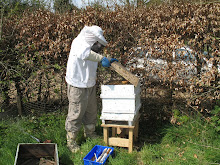



Not the best of days for bee keeping. Forecast was for showers and it did just that. Judith and I turned up early and put a gazebo over hives 1 and 3. Half the students from the Hills Road Bee Keepers course turned up at 10 am. We had a cup of coffee while discussing hive records and planning the inspection. Due to the weather, we would only look at the two hives under cover. We started in hive 3 which I was expecting to contain a new queen. Wrong, there was no queen. Just a few Drone cells, no eggs, no larvae and workers on 3 frames.
We moved onto hive 1. Much better. The bees were working the super to begin with. We looked at a couple of super frames, but the honey was not capped even though there is honey (nectar) in all the frames. We then examined the queen excluder and then into the brood box. The first frame was mostly stores with a few capped brood cells. The second frame was mostly filled with capped brood. The students then took out a frame each in turn and examined it. We found the marked queen. We saw eggs, larvae and capped brood, both worker and drone. We looked at the bigger body and eyes of the drone.
We took a frame of eggs and young larvae from hive 1 and donated it to hive 3 in the hope that they will raise another queen. We then fed the swarm that arrived yesterday. Finally we examined the varroa trays of hives 1 and 2. Could not find any varroa. Good for the bees, but I would have liked to find one to show the students. We then packed up, took down the gazebo and left the bees alone.
On the way out, security reported that a swarm had been reported in Huntingdon. Judith got the details and we passed that one on to one of the Huntingdon Bee Keepers Association members to collect.











